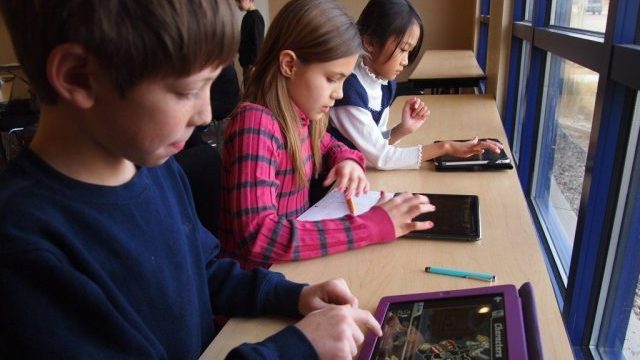
Is technology in the classroom really a good idea?
Something magical happens when you put Apple products in your classroom. You can create unique opportunities for personal learning at every level. Lessons become more immersive through the power of touch, motion, and sound. Assignments can be sketched, scored, charted, coded, or performed. And the work your students need to do becomes the work they love to do.
So says the introduction to Apple’s Education pages, which include information on the new Classroom iPad application and resources to help with the deployment of iPads and other Apple products in classrooms.
But do iPads and computers in classrooms really assist learning?
Ashley Wainright lists eight studies showing improved education outcomes through the use of iPads in kindergartens, schools and universities. Examples from the eight include a middle school pilot study using an iPad text for Algebra 1 courses, and the iMedEd Initiative, a medical education program based on iPad tablet computing at the University of California, Irvine.
The middle school pilot study1 carried out by textbook publishers Houghton Mifflin Harcourt, “found that 20% more students (78% compared to 59%) scored ‘Proficient’ or ‘Advanced’ in subject comprehension when using tablets rather than paper textbook counterparts.”
The first class participating in the iMedEd Initiative “scored an average of 23 percent higher on their national exams – taken at the end of the second year of medical school – than previous UC Irvine medical school classes, despite having similar incoming GPAs and MCAT scores.”
Contrasting this, Matthew Jenkin writes in The Guardian about the Waldorf School in Silicon Valley attended by the children of the employees of Apple and other technology giants. The parents of the pupils work in major technology companies, but in the school “there is not an iPad, smartphone or screen in sight.” The article uses this dichotomy to question if technology in classrooms is really in the best interest of education outcomes. Other examples of schools where technology use is restricted are also given.
Jenkins references a global report2 by the Organisation for Economic Co-operation and Development (OECD) that supports the view that technology in the classroom has questionable benefit. He says that the report “suggests education systems that have invested heavily in computers have seen “no noticeable improvement” in their results for reading, maths and science in the Programme for International Student Assessment (Pisa) tests.”
However, in their Updated Review of the Global Use of Mobile Technology in Education3, educational charity Techknowledge for Schools alerts that the OECD “report and the coverage it received was met with some criticism however by both academics and school leaders.” The Techknowledge for Schools review further states that “the PISA tests, from which the OECD report draws its attainment evidence, have long been criticised by academics and school leaders for their narrow scope,” and that “Dr Monica Bulger of the Oxford Internet Institute has argued that the methodology behind the OECD report is flawed, particularly the way it measures technology use.”
Techknowledge for Schools is working to bring an evidence-based approach to understanding the impacts, benefits and benefits of using technology such as iPads in education. Their Updated Review of the Global Use of Mobile Technology in Education concludes that while there are still concerns in regard to evidence of a direct impact on learning from technology, “recent published papers in peer-reviewed journals indicate that there is a growing evidence base illustrating that technology has a beneficial effect on education.”
Techknowledge for Schools advises that how technology is implemented is critical, stating that:
Schools cannot adopt mobile technology without support:
- they need additional teacher training
- advice on infrastructure
- technical assistance
- evidence of benefits
- guidelines on esafety
- information on new teaching methods that encompass the technology
An article in the Sydney Morning Herald further advises that teaching computer literacy in schools is important if students are to develop essential workplace computer skills.
Image source: student_ipad_school – 124 by Brad Flickinger is licensed by CC BY 2.0.
References:
- Houghton Mifflin Harcourt. (2012). Results of a yearlong Algebra pilot in Riverside. CA. ↩
- OECD. (2015). Students, Computers and Learning: Making the Connection. PISA, OECD Publishing. ↩
- Clarke, B., & Svanaes, S. (2016). Updated review of the global use of mobile technology in education. Techknowledge for Schools. ↩
Also published on Medium.






